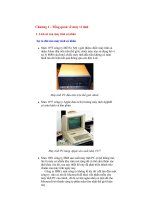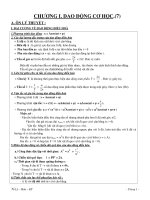Chương 1: W1 coa introduction
Bạn đang xem bản rút gọn của tài liệu. Xem và tải ngay bản đầy đủ của tài liệu tại đây (2.68 MB, 38 trang )
Computer Organization and Architecture
(Tổ chức và Kiến trúc Máy tính)
Chapter 1
Introduction
Adapted from Computer Organization and Design, 4th Edition,
Patterson & Hennessy, © 2008, MK
Adapted from Mary Jane Irwin, Penn State University
Contents
1 • Introduction
2 • Below Your Program
3 • Components of a Computer
Chapter 1 — Introduction— 3
What You Will Learn
Lịch sử phát triển của máy tính
Làm thế nào để chương trình được dịch
sang ngôn ngữ máy?
Và làm thế nào để phần cứng thực thi ?
Giao tiếp phần cứng/phần mềm
Chapter 1 — Introduction— 3
The Computer Revolution §1.1 Introduction
Sự tiến bộ trong cơng nghệ máy tính
Định luật Moore
Ứng dụng phổ biến
Lĩnh vực ô tô
Điện thoại di động
World Wide Web
Cơng cụ tìm kiếm
Máy tính ngày càng phổ biến
Chapter 1 — Introduction— 3
The Computer evolution
Transistor đầu tiên được phát minh khi nào?
Được phát minh năm 1947 bởi Bardeen và cộng sự
tại Bell Laboratories
Chapter 1 — Introduction— 3
The Computer evolution
Phiên bản đầu
tiên của
transitor
Chapter 1 — Introduction— 3
The Computer evolution
Mạch tích hợp (Integrated circuit – IC) được
phát minh khi nào?
Năm 1958, IC tạo ra bởi Jack Kilby (Texas
Instruments)
Chapter 1 — Introduction— 3
MOORE’s Law
Chapter 1 — Introduction— 3
MOORE’s Law con’t
Intel 4004 2,300 1971 Intel 10,000 nm 12 mm²
10,000 nm 14 mm²
Intel 8008 3,500 1972 Intel 6,000 nm 20 mm²
Intel 8080 4,500 1974 Intel
IBM z13 3,990,000,000 2015 IBM 22 nm 678 mm²
IBM z13 Stora 7,100,000,000 2015 IBM 22 nm 678 mm²
ge Controller Intel 14 nm 122 mm²
Oracle 20 nm
Quad-core + cca 2015 Intel 14 nm 456 mm²
GPU GT2 1,750,000,000
Core i7 Skyla 10,000,000,00
ke K 0[33] 2015
SPARC M7
22-core ~7,200,000,0 2016
Xeon Broadw 00[32]
ell-E5
Chapter 1 — Introduction— 3
Technology trend
Chapter 1 — Introduction— 3
Technology Outlook
High Volume 2004 2006 2008 2010 2012 2014 2016 2018
Manufacturing
90 65 45 32 22 16 11 8
Technology Node
(nm) 2 4 8 16 32 64 128 256
Integration
Capacity (BT) 0.7 ~0.7 >0.7 Delay scaling will slow down
Delay = CV/I
scaling >0.35 >0.5 >0.5 Energy scaling will slow down
Energy/Logic Op High Probability Low Probability
scaling
Bulk Planar CMOS Low Probability High Probability
Alternate, 3G etc Medium High Very High
Variability ~3 <3 Reduce slowly towards 2 to 2.5
ILD (K) 1 1 1 1 1 1 1 1
RC Delay 6-7 7-8 8-9 0.5 to 1 layer per generation
Metal Layers
Chapter 1 — Introduction— 3
Technology Trends
Electronics DRAM capacity
technology
continues to evolve
Increased capacity
and performance
Reduced cost
Year Technology Relative performance/cost
1951 Vacuum tube 1
1965 Transistor
1975 Integrated circuit (IC) 35
1995 Very large scale IC (VLSI) 900
2005 Ultra large scale IC 2,400,000
6,200,000,000
Chapter 1 — Introduction— 3
The PowerPC 750
Introduced in
1999
3.65M transistors
366 MHz clock
rate
40 mm2 die size
250nm
(0.25micron)
technology
Chapter 1 — Introduction— 3
Technology: 14nm
# of Cores 4
# of Threads 8
Processor Base 2.8 GHz
Frequency
Max Turbo 3.6 GHz
Frequency
Cache 8 MB
SmartCache
Bus Speed 8 GT/s DMI3
TDP 35 W
Chapter 1 — Introduction— 3
Impacts of Advancing Technology
Processor
logic capacity: increases about 30% per year
performance: 2x every 1.5 to 2 years
Memory
DRAM capacity: 4x every 3 years, about 60% per
year
speed: 1.5x every 10 years
cost per bit: decreases about 25% per year
Disk
capacity: increases about 60% per year
speed:
cost per bit:
Chapter 1 — Introduction— 3
Growth Capacity of DRAM Chips
K = 1024 (210) In recent years growth
rate has slowed to 2x
every 2 year
Chapter 1 — Introduction— 3
Classes of Computers
Máy tính cá nhân - Desktop computer
Phục vụ mục đích chung, phần mềm đa dạng
Hiệu suất và chi phí thấp.
Máy chủ - Server computer
Network based – truy cập từ xa qua mạng.
Hiệu suất, dung lượng và độ tin cậy cao.
Thực hiện khối lượng công việc lớn, các chức
năng chuyên biệt
Máy tính nhúng - Embedded computer
Được nhúng trong một hệ thống
Công suất, chi phí thấp, dùng cho một ứng
dụng cụ thể
Chapter 1 — Introduction— 3
Classes of Computers
Siêu máy tính - Supercomputers
Công suất cao, chi phí cao.
Bao gồm hàng trăm đến hàng ngàn bộ xử lý
Dung lượng lưu trữ từ terabytes -> petabytes
Chapter 1 — Introduction— 3
Review:
Kilobyte – 210 or 1,024 bytes
Megabyte– 220 or 1,048,576 bytes
sometimes “rounded” to 106 or 1,000,000 bytes
Gigabyte – 230 or 1,073,741,824 bytes
sometimes rounded to 109 or 1,000,000,000 bytes
Terabyte – 240 or 1,099,511,627,776 bytes
sometimes rounded to 1012 or 1,000,000,000,000 bytes
Petabyte – 250 or 1024 terabytes
sometimes rounded to 1015 or 1,000,000,000,000,000
bytes
Exabyte – 260 or 1024 petabytes
Sometimes rounded to 1018 or 1,000,000,000,000,000,000
bytes
Chapter 1 — Introduction— 3
Growth in Cell Phone Sales (Embedded)
• Where else are embedded processors found?
Chapter 1 — Introduction— 3









